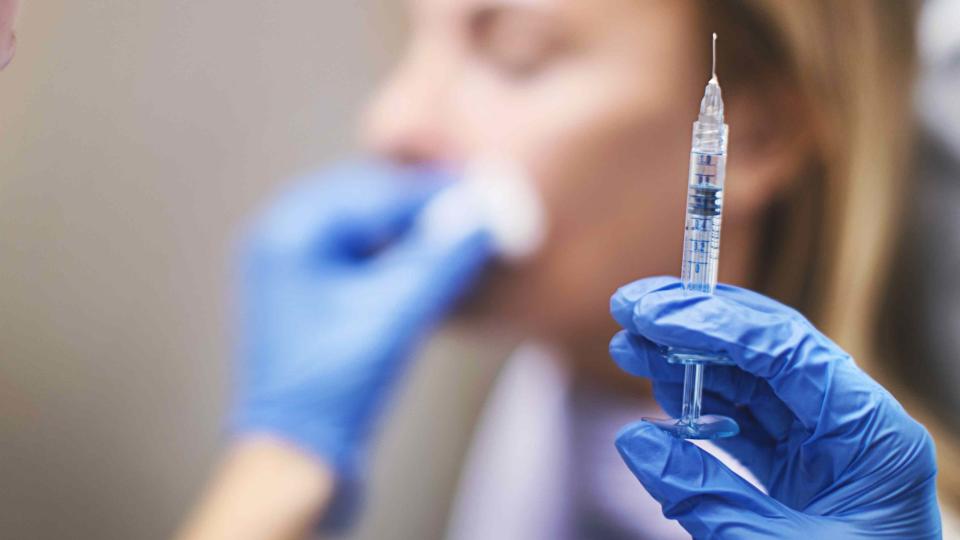What to Know About Using Botox for Jaw Muscles
The wrinkle reducer does so much more than you might think.

Getty Images
If it seems like everyone is forever chasing a snatched, sharp-as-glass jawline, it's because they are. As the face ages naturally, it's common for the jawline to lose its sharp definition. Injectables may be a go-to treatment for smoothing out fine lines and keeping wrinkles at bay, but you can also use Botox for jaw-dropping benefits (pun intended!).
A few injections of strategically-placed Botox — sometimes coupled with other aesthetic treatments — can be the defining factor for a smooth, taut jawline. Beyond its anti-wrinkle uses, many injectors believe Botox is also the best solution for alleviating grinding and clenching and even improving symptoms of temporomandibular jaw syndrome (TMJ). Here, everything there is to know about using Botox for jaw muscles and slimming the face.
Related: Botox vs. Fillers: Which Injectable Is Right for You?
The Benefits of Botox for the Jaw
According to Adrienne O'Connell, DO, aesthetic medicine doctor and founder of Laguna Beach Aesthetics, injecting Botox into the masseter (or jaw) muscles can slim and tighten the jawline, decrease teeth grinding and clenching and even improve TMJ. "Botox relaxes the masseter muscles, a fairly large muscle along the lower posterior jaw on either side."
But if left untreated, says board-certified dermatologist and psychiatrist Amy Wechsler, MD, pain, headaches, and squaring of the jawline can ensue. Over time, there can also be facial muscle hypertrophy, tooth damage, jaw pain and stiffness, and sleep disruption.
While injecting Botox into the jaw relieves stress-induced tension, Sari Katz, PA-C, an advanced cosmetic injector and national trainer for the Allergan Medical Institute, says it is also beneficial for treating TMJ disorder. "With TMJ, the joint and muscles of the jaw have pathology that causes muscle tension leading to pain and stiffness, and sometimes affecting the ability to open or close the mouth," she says.
Unlike bulky bite plates and other annoying dental appliances that may help alleviate the symptoms of TMJ, a few quick injections of Botox is a painless way to weaken the masseter muscles and improve the disorder.
How Botox Slims the Jawline
From an aesthetic standpoint, treating the jaw with Botox slims the lower face. With age, collagen and elastin production and facial volume decrease, and the facial bones lose density and resorb, resulting in a loss of skin firmness and elasticity and less jawline structural support.
"These changes lead to sagging and tissue laxity along the jawline and jowls for a less defined jawline," Katz says. Plus, treating the muscles in the back of the jawline with Botox helps to slim the lower face and balance out facial proportions for a softer, more feminine appearance and less width in the jawline. "The face can also appear more heart- or oval-shaped than a masculine shape like square or rectangle," she says.
Related: Why Baby Botox Is TikTok's Favorite Aesthetic Treatment
There's no denying how impactful a few injections of Botox are when it comes to enhancing the lower third of the face and the face as a whole; however, if you use Botox to slim the jaw or for other reasons, Dr. Wechsler points out that it won't improve aging of the jaw.
Who Is a Good Candidate?
Jawline Botox injections are helpful for anyone with enlarged masseter muscles who desires a less bulky-looking jawline, needs to lessen the intensity and frequency of jaw clenching, or wants to address grinding or alleviate TMJ symptoms. Dr. O'Connell assesses potential patients by having them clench their jaw, which allows her to see the masseter muscle pop out visibly. If the muscles bulge, the person is likely a candidate for treatment.
Although jawline Botox offers several advantages, Katz notes that if someone has too much laxity or sagging in the jowl area from aging, the jawline's appearance may worsen with Botox. "Relaxing the muscles at the back of the jaw can shift some of the facial tissues toward the jowl area," she says. "That is why candidate selection and pretreatment evaluation are crucial."
How is Jaw Botox Performed?
After assessing and cleansing the area, your injector or dermatologist will outline the muscle with a white chalk pencil to determine precisely where to inject Botox. Since the degree of muscle enlargement varies from person to person, there's no set dose for treating the jawline. (On average, though, about 20 units of a neuromodulator are into each masseter muscle to relax the muscles.)
Dr. Wechsler says jaw Botox is a well-tolerated procedure that feels like small shots. "Numbing cream may be used beforehand but is often not needed." The procedure takes only a few minutes and has minimal downtime.
To limit the risk of unwanted side effects, seeking treatment with a professional provider who is well-versed in facial anatomy is always best. "If they are not injecting the masseter muscle appropriately, it can cause the smile to drop," Dr. O'Connell says. "Conversely, injecting too superficially into the masseter can cause a bulging effect."
The effects of Botox will kick in over the next three to 10 days. If you are having the treatment to improve signs of clenching, you'll slowly begin to feel less stress on the lower jaw. But just like Botox for aesthetic purposes, the results will last a few months, and repeat treatments are necessary to maintain the benefits.
Related: 6 Post-Botox Mistakes Way Too Many People Are Making
For more InStyle news, make sure to sign up for our newsletter!
Read the original article on InStyle.

 Yahoo Sports
Yahoo Sports 